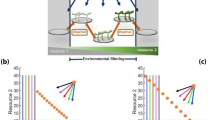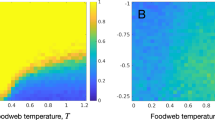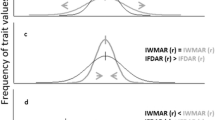Abstract
Local-regional species richness relationships have been used to infer relative contributions of local and regional forces to determining the richness of local communities. Although most previous research assumed competition as major local species interactions, growing empirical evidence suggests that facilitation is also an important driver of local community dynamics. Here, I explore how facilitation affects the shape of local-regional richness relationships, by incorporating local facilitation into a patch-occupancy model of metacommunity dynamics. I find that facilitation can generate local-regional richness relationships with the alternative stable states of mean local richness at intermediate to high levels of regional richness. These alternative stable states tend to occur in a metacommunity in moderately harsh environments. This result cautions against assuming that only competition can be primarily important local interactions when interpreting the shapes of local-regional richness relationships. Moreover, the possibility of alternative stable states suggests that gradual decline of regional species diversity might cause a sudden collapse of metacommunities with local facilitation.





Similar content being viewed by others
References
Bell G (2003) The interpretation of biological surveys. Proceedings of the Royal Society of London, Series B 270:2531–2542
Bergvall UA, Rautio P, Kesti K, Tuomi J, Leimar O (2006) Associational effects of plant defences in relation to within- and between-patch food choice by a mammalian herbivore: neighbour contrast susceptibility and defence. Oecologia 147:253–260
Bertness MD, Callaway R (1994) Positive interactions in communities. Trends Ecol Evol 9:191–193
Bertness MD, Leonard GH (1997) The role of positive interactions in communities: lessons from intertidal habitats. Ecology 78:1976–1989
Brooker RW, Callaway RM (2009) Facilitation in the conceptual melting pot. J Ecol 97:1117–1120
Brooker RW, Maestre FT, Callaway RM, Lortie CL, Cavieres LA, Kunstler G, Liancourt P, Tielborger K, Travis JMJ, Anthelme F, Armas C, Coll L, Corcket E, Delzon S, Forey E, Kikvidze Z, Olofsson J, Pugnaire F, Quiroz CL, Saccone P, Schiffers K, Seifan M, Touzard B, Michalet R (2008) Facilitation in plant communities: the past, the present, and the future. J Ecol 96:18–34
Bruno JF, Stachowicz JJ, Bertness MD (2003) Inclusion of facilitation into ecological theory. Trends Ecol Evol 18:119–125
Callaway RM, Walker LR (1997) Competition and facilitation: a synthetic approach to interactions in plant communities. Ecology 78:1958–1965
Callaway RM, Reinhart KO, Moore GW, Moore DJ, Pennings SC (2002) Epiphyte host preferences and host traits: mechanisms for species-specific interactions. Oecologia 132:221–230
Caswell H, Cohen JE (1993) Local and regional regulation of species-area relations: a patch-occupancy model. In: Richlefs RE, Schulter D (eds) Species diversity in ecological communities: historical and geographical perspectives. The University of Chicago Press, Chicago, USA, pp 99–107
Cavieres LA, Badano EI (2009) Do facilitative interactions increase species richness at the entire community level? J Ecol 97:1181–1191
Cornell HV (1985) Local and regional richness of cynipine gall wasps on California oaks. Ecology 66:1247–1260
Cornell HV, Lawton JH (1992) Species interactions, local and regional processes, and limits to the richness of ecological communities - a theoretical perspective. J Anim Ecol 61:1–12
Fukami T (2004) Community assembly along a species pool gradient: implications for multiple-scale patterns of species diversity. Popul Ecol 46:137–147
Gross K (2008) Positive interactions among competitors can produce species-rich communities. Ecol Lett 11:929–936
Hacker SD, Gaines SD (1997) Some implications of direct positive interactions for community species diversity. Ecology 78:1990–2003
Harada Y, Iwasa Y (1994) Lattice population-dynamics for plants with dispersing seeds and vegetative propagation. Res Popul Ecol 36:237–249
Harrison S, Cornell H (2008) Toward a better understanding of the regional causes of local community richness. Ecol Lett 11:969–979
Hastings A (1987) Can competition be detected using species co-occurrence data. Ecology 68:117–123
Hegland SJ, Grytnes JA, Totland O (2009) The relative importance of positive and negative interactions for pollinator attraction in a plant community. Ecol Res 24:929–936
Hugueny B, Cornell HV, Harrison S (2007) Metacommunity models predict the local-regional species richness relationship in a natural system. Ecology 88:1696–1706
Hunter AF, Aarssen LW (1988) Plants helping plants. Bioscience 38:34–40
Kéfi S, Rietkerk M, Alados CL, Pueyo Y, Papanastasis VP, ElAich A, de Ruiter PC (2007) Spatial vegetation patterns and imminent desertification in mediterranean arid ecosystems. Nature 449:213–U215
Levins R (1969) Some demographic and genetic consequences of environmental heterogeneity for biological control. Bull Entomol Soc Am 15:237–240
MacArthur RH, Wilson EO (1967) The theory of island biogeography. Princeton University Press, Princeton, USA
Michalet R, Brooker RW, Cavieres LA, Kikvidze Z, Lortie CJ, Pugnaire FI, Valiente-Banuet A, Callaway RM (2006) Do biotic interactions shape both sides of the humped-back model of species richness in plant communities? Ecol Lett 9:767–773
Mouquet N, Loreau M (2003) Community patterns in source–sink metacommunities. Am Nat 162:544–557
Niering WA, Whittaker RH, Lowe CH (1963) The saguaro: a population in relation to environment. Science 142:15–23
Ricklefs RE (1987) Community diversity—relative roles of local and regional processes. Science 235:167–171
Ricklefs RE (2004) A comprehensive framework for global patterns in biodiversity. Ecol Lett 7:1–15
Ricklefs RE (2007) History and diversity: explorations at the intersection of ecology and evolution. Am Nat 170:S56–S70
Ricklefs RE, Schulter D (1993) Species diversity in ecological communities: historical and geographical perspectives. University of Chicago Press, Chicago, USA
Rietkerk M, Koppel Jvd (1997) Alternate stable states and threshold effects in semi-arid grazing systems. Oikos 79:69–76
Russell R, Wood SA, Allison G, Menge BA (2006) Scale, environment, and trophic status: the context dependency of community saturation in rocky intertidal communities. Am Nat 167:E158–E170
Shurin JB, Allen EG (2001) Effects of competition, predation, and dispersal on species richness at local and regional scales. Am Nat 158:624–637
Shurin JB, Srivastava DS (2005) New perspectives on local and regional diversity: beyond saturation. In: Holyoak M, Leibold MA, Holt R (eds) Metacommunities: spatial dynamics and ecological communities. University of Chicago Press, Chicago, USA, pp 399–417
Shurin JB, Havel JE, Leibold MA, Pinel-Alloul B (2000) Local and regional zooplankton species richness: a scale-independent test for saturation. Ecology 81:3062–3073
Srivastava DS (1999) Using local-regional richness plots to test for species saturation: pitfalls and potentials. J Anim Ecol 68:1–16
Wilson WG, Nisbet RM (1997) Cooperation and competition along smooth environmental gradients. Ecology 78:2004–2017
Witman JD, Etter RJ, Smith F (2004) The relationship between regional and local species diversity in marine benthic communities: a global perspective. Proc Natl Acad Sci USA 101:15664–15669
Acknowledgments
I thank comments from two anonymous reviewers that improved the earlier manuscript. This work was supported by Japan Society for the Promotion of Science (KAKENHI #21770091).
Author information
Authors and Affiliations
Corresponding author
Appendices
Appendix A
Approximate equations for the mean and variance of local richness
I derive two equations describing the dynamics of the mean and variance of local richness, \( L = \sum\nolimits_{m = 0}^R {{{m}}{{{p}}_m}} \) and \( V = \sum\nolimits_{m = 0}^R {{{\left( {m - L} \right)}^2}{p_m}} \), respectively, from the full equations (8a). To obtain the equation for L, multiply both sides of all R + 1 equations of (8a, b, c) by m. Then adding the left- and right-hand sides of these equations yields
The dynamic equation for V is similarly obtained by multiplying both sides of all R + 1 equations in (8a–c) by (m–L)2, and adding all terms on each side across all equations.
These equations are not closed in terms of L and V. To obtain closed forms, the functions g m , S m , and e m are Taylor expanded with respect to m around L, and plugged into equations (A1a and b). Neglecting the third- or higher-order terms, closed equations are
where \( g_L^\prime \), \( g_L^{\prime \prime } \), \( s_L^\prime \), \( s_L^{\prime \prime } \), \( e_L^\prime \), and \( e_L^{\prime \prime } \) are the first and second derivatives of g m , s m , and e m , respectively, with respect to m evaluated at L. Once the functions g m , s m , and e m are specified, equations (A2) can be used to find approximate values of equilibrium local richness and variance. I confirmed that the approximate equilibrium values show good correspondence to the equilibrium values based on equations (7b).
Moreover, these approximate equations can be used to study analytically the changes of mean and variance of local richness along the gradient of regional richness. These results provide an analytical proof for the existence of alternative stable states in facilitative metacommunities. There are at least five cases (I-V) that are analytically tractable. Case I assumes neutral local interactions, in which I set g m = G, S m = S, and e m = E (when α = β = 0 and S = T). Case II assumes competitive local interactions, in which the immigration rate is inversely related to local richness (g m = G/m, s m = S, and e m = E, when α = −1, S = T, and β = 0). Case III also assumes competitive interactions, in which the extinction rate is linearly related to local richness (g m = G, s m = S, and e m = Em, when α = 0, S = T, and β = 1). Case IV assumes facilitative local interactions, in which the immigration rate is a linear function of local richness (g m = Gm, s m = S, and e m = E, when α = 1, S = T, and β = 0). Case V also assumes facilitative interactions, in which the extinction rate is inversely related to local richness (g m = G, s m = S, and e m = E/m, when α = 0, S = T, and β = −1). Approximate equations and the equilibrium values of L and V for cases (I-V) are summarized in Table 1.
Appendix B
A simulation model incorporating species difference in facilitative performance
The patch-occupancy model in the main text assumes no difference in species. Here I develop another simulation model to confirm that alternative stable states can occur in metacommunities with local facilitation even when species differ in their facilitative performance. I model a metacommunity consisting of a number of local communities linked by dispersal. For simplicity, I assume that there is no difference in environmental conditions among local communities. I formulate a discrete-time system, in which the following sequence of events occurs within a unit time step: (1) within-community local interactions, (2) local extinction due to low densities, (3) local extinction due to local disturbance, and (4) between-community dispersal.
Denote z ij (t) as the density of the j-th species in the i-th local community at time t. Local interactions change the density z ij (t) to w ij (t) according to the following equation.
where r is the basic birth rate and m is the basic death rate. a jk represents the per capita facilitative effect of the k-th species on the j-th species (a jk ≥ 0 and a jj = 0). Different values of a jk confer that different species have different facilitative effects on one another. The term \( m/\left( {1 + \sum\limits_{j = 1}^R {{a_{jk}}{z_{ik}}(t)} } \right) \) means that the death rate decreases as the richness and/or densities of facilitative species becomes greater, and/or as the per capita facilitative effects become stronger. b jk (>0) represents the per capita competitive effect of the k-th species on the j-th species (when j ≠ k) and self-limitation (when j = k).
If local species densities fall below a certain threshold (Ω), I assume that such species become extinct from local communities. I denote as x ij (t) the species densities after this extinction due to low densities. Further, I assume that local disturbance, such as physical destruction, physiological stress, predation, or disease outbreak, can occur at a given rate (∆) randomly on every species in every community. When this local disturbance strikes a local population, it drives the population into extinction. I denote the species densities after this disturbance-driven extinction as y ij (t).
Finally, a fixed fraction (Ψ) of the member of each local population disperse. The total number of dispersers of the j-th species is \( a\sum\limits_{i = 1}^M {\Psi {y_{ij}}(t)} \). The probability that a local community receives dispersers are assumed as \( \sum\limits_{i = 1}^M {\Psi {y_{ij}}(t)} /\left( {H + \sum\limits_{i = 1}^M {\Psi {y_{ij}}(t)} } \right) \), where H is a fixed constant. The number of dispersers is equally distributed among the local communities that receive dispersers. Dispersal completes the sequence of events within a unit time-step, and yields the species densities of each local community at the next time-step.
Simulation of this model is performed for 200 time-steps, and then the mean of local richness is calculated. Survey of parameter space has found sets of parameter values with which simulations starting from different initial species densities lead to either positive or zero mean local richness after 200 time-steps. The probability of attaining positive mean local richness increased as initial local richness increased (Fig. 5). This suggests the existence of alternative stable states of mean local richness, implying that alternative stable states may be a general characteristic of facilitative metacommunities regardless of the assumption of species difference.
Rights and permissions
About this article
Cite this article
Takimoto, G. Local-regional richness relationships and alternative stable states in metacommunities with local facilitation. Theor Ecol 4, 385–395 (2011). https://doi.org/10.1007/s12080-010-0085-x
Received:
Accepted:
Published:
Issue Date:
DOI: https://doi.org/10.1007/s12080-010-0085-x




